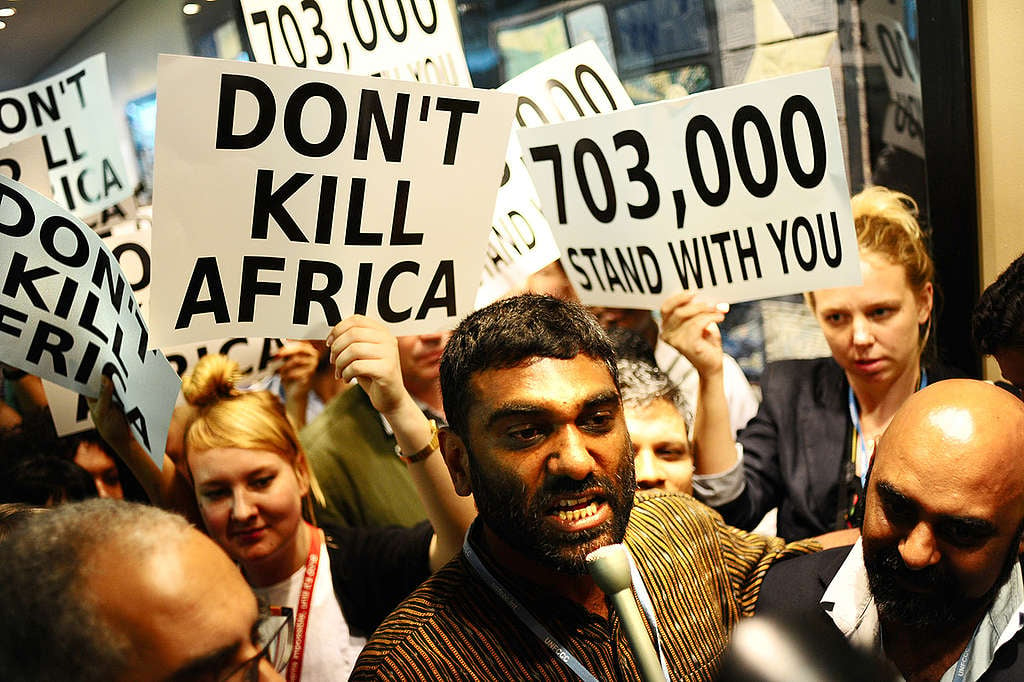Johannesburg, 24 October 2019 — South Africa’s inadequate nuclear liability regulations[1] have finally been updated and gazetted[2] by Minister of Mineral Resources and Energy Gwede Mantashe. This news comes after almost six years of Greenpeace Africa pushing the Minister to do so to protect taxpayers from the potentially astronomical costs of a nuclear accident.
“We can finally celebrate the fact that the financial liability on nuclear power station operators in the case of a nuclear accident has been more than tripled[3]. This is a long-awaited victory after Greenpeace Africa filed papers with the Pretoria High Court in 2015 to compel then-Minister of Energy, Tina Joemat-Pettersson, to update South Africa’s ridiculously inadequate nuclear liability regulations,” said Melita Steele, Senior Climate and Energy Campaign Manager for Greenpeace Africa.
Nuclear investments carry a hefty price tag and would take at least 15 years to deliver any electricity to the grid which, in the face of South Africa’s recent bouts of loadshedding, are far from worth the wait. Investments into renewable energy technologies offer a cost-effective and safe alternative which can feed electricity into the national grid significantly sooner and significantly more cheaply than nuclear.
“This increase in financial liability for all types of nuclear installations in South Africa is a stark warning to those who have – or propose to have – nuclear licences in South Africa: they will have to pay a substantially bigger portion of any costs of a cleanup after a nuclear accident. They now bear a far bigger liability for a nuclear accident, while taxpayers are a little more protected,” added Steele.
Section 29 (1) and Section 29 (2) of the National Nuclear Regulator Act, 47 of 1999 states that the Minister of Energy must, on the recommendation of the board and in consultation with the Minister of Finance, determine the appropriate levels of financial security to be provided by the holders of nuclear licences in South Africa[4]. According to the regulations, the levels of nuclear liability should be updated every five years. The levels of financial security for nuclear licence holders had not been amended, updated or revised in nearly 15 years. This means that what was contained in the regulations was out of date, completely inadequate, and inconsistent with South Africa’s constitution, prompting Greenpeace Africa’s legal action.
“The full human and environmental costs of the Fukushima nuclear disaster are yet to be tallied, but estimates are at over R500 billion. This pales in comparison to South Africa’s new level of liability of R7.4 billion, but is a very significant increase from the R2.4 billion levels set in 2004. Make no mistake: nuclear is never safe, and is always at risk from a deadly combination of human error and technology breakdowns. This increase in financial liability offers more protection for taxpayers, but will still not truly shield us from the full costs of any nuclear accident,” continued Steele.
Over the past four and a half years, Greenpeace has sent numerous legal letters to ensure that the Minister comply with the law and update the levels of financial security, taking into account the costs of Fukushima. Submissions were also made by Greenpeace in the 2017 public participation process. The organisation has maintained consistent legal engagement with the Department regarding the urgency of updating the nuclear liability regulations since then.
“The fact is, no amount of money is enough to fairly compensate for the human and environmental cost of a nuclear disaster. Greenpeace’s long-running pursuit of this legal action is a reminder to government that South Africa is ill-prepared for nuclear investments and should rather focus on solutions like renewable energy that can deliver today. It is also a reminder that civil society organisation will not tire of pursuing social and environmental justice in South Africa through all avenues available to them,” ended Steele.
CONTACT DETAILS:
Chris Vlavianos, Communications Officer for Greenpeace Africa, 079 883 7036, [email protected]
NOTES TO THE EDITOR:
- Nuclear liability refers to the levels of financial security to be provided by holders of nuclear installation licenses in the event of a nuclear incident.
- The new gazetted regulations can be found here.
- Table comparing original (2004) levels of liability to new (2019) levels of liability.
The levels have tripled for category 1 installations, the levels for category 2 installations has increased by more than 7 times what it was in 2004 and, in the case of category 3 installations, by more than 120 times the requirement in 2004.
| Nuclear Installation Type | Year | |
| 2004 | 2019 | |
| Category 1 installation
Koeberg Nuclear Power Station |
R2.4bn | R7.4bn |
| Category 2 installation
The following nuclear installations on the Necsa Pelindaba site: SAFARI-1 Research Reactor; P270 Complex (UCHEM); ELPROD in Building P25; and NTP Radiochemicals Complex (Hot Cell Complex). |
R120m | R888m |
| Category 3 installation
Vaalputs National Radioactive Waste Disposal Facility The following nuclear installations on the Necsa Pelindaba site: Thabana Complex HEU Vault A-8 Decontamination Facility Building A-West Drum Store UMET in Building P2600 Conversion Plant Complex Area 14 Waste Management Complex Quarantine Storage Facility V-YB Pelindaba East Bus Shed Complex; Pelindaba East Evaporation Ponds Complex Oil Purification Facility Area 21 Storage Facility Beva K3 Storage Complex Area 16 Complex Area 40 Complex Area 27 De-Heeling Facility J- Building; D- Building; C- Building Building P2900 Building XB Beva Evaporation Ponds Building P-2800 Area 26 E-Building Dorbyl Camp X- Building Building P-1500 YM Vacuum Workshop V-H Building Laboratories P-1900 Laboratories P-160 0Laboratories Fuel Development Laboratories Complex Pelindaba Analytical Laboratories (PAL) in Building BEVA-El Liquid Effluent Treatment facility B-1 Building Basement |
R1m | R121m |
- In consultation with the Minister of Finance, and based on the recommendations from the Board of the National Nuclear Regulator.
 Get Involved
Get Involved
